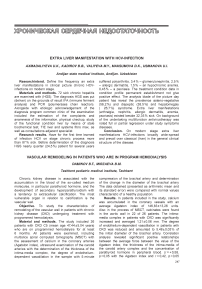Extra liver manifestation with HCV-infection
Автор: Axmadaliyeva U.K., Kadirov B.B., Valiyeva M.Y., Maksumova D.K., Usmanova U.I.
Журнал: Евразийский кардиологический журнал @eurasian-cardiology-journal
Рубрика: Хроническая сердечная недостаточность
Статья в выпуске: S2, 2019 года.
Бесплатный доступ
Define the frequency an extra liver manifestations in clinical picture chronic HCV-infections on modern stage.
Короткий адрес: https://sciup.org/143170247
IDR: 143170247
Текст статьи Extra liver manifestation with HCV-infection
Research results. Have for the first time learned of infection HCV on stage chronic process more than 87 % sick. Before determination of the diagnosis HGS nearly quarter (24,5 %) patient for several years suffered polyarthritis, 3,4 % – glomerulonephritis, 2,5 % – allergic dermatitis, 1,5 % – an hypochromic anemia, 0,45 % – a psoriasis. The treatment condition data in condition profile permanent establishment not give positive effect. The analysis blade of the picture day patient has reveal the prevalence asteno-vegetative (56,2 %) and dispeptic (38,5 %) and hepatomegaly ( 26,7 %) syndrome. Extra liver manifestations (arthralgia, nephritis, allergic dermatitis, anemia, psoriasis) existed beside 32,35 % sick. On background of the undertaking multifunction antivirustherapy was noted full or partial regression under study symptoms diseases.
Conclusion. On modern stage extra liver manifestations HCV-infections broadly wide-spread and prevail over classical (liver) in the general clinical structure of the disease.
VASCULAR REMODELING IN PATIENTS WHO ARE IN PROGRAM HEMODIALYSIS
DAMINOV B.T., MIRZAEVA B.M.
Tashkent pediatric medical institute, Tashkent
Chronic kidney disease is associated with the accumulation in the blood of the so-called medium molecules, in particular parathyroid hormone, and the development of secondary hyperparathyroidism with a tendency to extracellular calcification. The most vulnerable organ in relation to calcification is the vascular wall.
Objective. To study the characteristics of remodeling of the vascular wall in patients with chronic kidney disease (CKD) undergoing treatment with programmed hemodialysis.
Material and methods. The study included 26 patients with CKD C5 (mean age 47,44 ± 5,04 years) who are on programmed hemodialysis for at least 6 months. All patients were examined, including multislice spiral computed tomography (MSCT) with the assessment of calcium in the coronary arteries (Agatston index), ultrasound examination of the carotid arteries with the determination of the thickness of the intima-media complex, the degree of endotheliumdependent vasodilation in the sample with 5-minute compression of the brachial artery and determination of the change in the diameter of the brachial artery The data obtained (presented as arithmetic mean and its standard error) were compared with normal values characteristic of a healthy population.
Results. In patients included in the study, calcium was accumulated in the coronary vessels with an average Agatston index of 146,83 ± 13,26 units. Also in the process of MSCT, calcinates were found in the aortic wall in 22 of 26 patients. The intimamedia complex in patients with CKD was significantly increased and averaged 1,21 ± 0,06 mm. The degree of endothelium-dependent vasodilation in patients with CKD was reduced and amounted to 5,48 ± 0,03 % of the initial diameter of the brachial artery. Correlation analysis revealed significant positive relationships between the average force between the value of the Agatson index, the thickness of the intima-media of the carotid artery complex and the concentration of parathyroid hormone in peripheral blood. (r = + 0,58, p < 0,05 with the Agatson index and r = 0,42, p < 0,05


